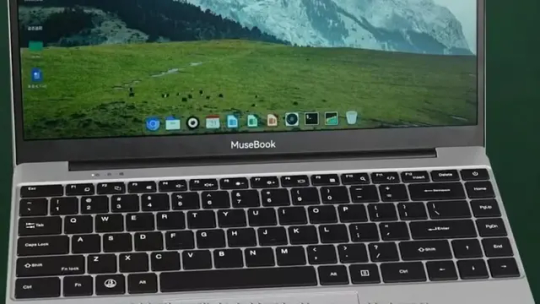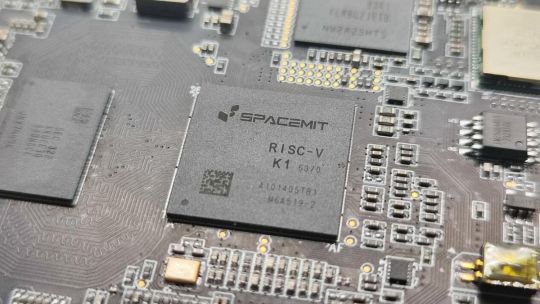#sdio
Explore tagged Tumblr posts
Text

First of the Bones Rises – RP2350 Adalogger 🦴
With the RP2350 chip in wide distribution , we're now able to come up with a lot of variants of our popular RP2040 "Bones"
https://blog.adafruit.com/2023/01/22/rp2040-feather-bones-for-a-few-different-varieties/
that ended up becoming a dozen different boards.
We're starting with the 'Adalogger' design folks love: with a microSD card socket that is wired for SPI or SDIO. A separate regulator allows the I2C/uSD to be powered off completely for ultra-low power usage. This didn't make as much sense for the RP2040 because it was not a particularly low-power chip. There's also a Stemma QT port for plugging in external sensors.
What other "Bones" should we spin up?
#rp2350#adalogger#raspberrypi#microcontroller#lowpower#devboard#stemmaqt#makerlife#electronicsprojects#openhardware#embeddeddev#hardwarehacking#iotdevelopment#datalogger#microsd#sdio#spi#i2c#engineering#programming#linux#python#java#software engineering#coding#regulators#featherbones#techinnovation#diytech#circuitdesign
15 notes
·
View notes
Text

ww
5 notes
·
View notes
Text

en otra ocasión, probablemente habría dejado pasar la forma en la que le habla e incluso todavía en su estado actual, siente que es capaz de justificarla pero le cuesta. "no eres la única que perdió a su mejor amiga." es lo único que se limita a decir, mandíbula ligeramente tensa y termina por soltarlo; realmente agradecía haberse encontrado con carmy antes. "nadie le va a creer a amelia, lo sabes, ¿no? está desesperada." entonces hace un ademán con la cabeza para ponerse en marcha hacía la cava, esperando que contraria la siguiera. "la última vez que revise, todavía quedaban botellas de whisky." comenta casual, sólo por cambiar un poco los aires.

“ mi mejor amiga está muerta, ahora amelia le está diciendo a todo el mundo que en realidad ella era mi mejor amiga, y que además soy una puta y una cazafortunas, así que... he estado mejor. ” ofrece sonrisa sardónica, utiliza actitud aparentemente despreocupada para esconder dolor genuino que sintió al escuchar los vídeos. “ sí, ¿por qué no? ” no es como que tuviera nada que perder, después de todo.
58 notes
·
View notes
Text
I'm hacking on an embedded system for work and it uses SDIO, which is a special type of SD card interface designed for communicating with non-storage devices. In this case, Wifi, because apparently the WIFI chip on this board is hooked up through the same interface as the SD card (probably to save on pins)
And it turns out SDIO is based on a metadata format defined way back in the old days of PCMCIA/CompactFlash (a very early standard for add-on cards for laptops and other portable devices) and thus it uses Card Information Structures and I'm having to deal with them.
In other words, the trans hacker is having to deal with CIS errors.
282 notes
·
View notes
Text

"New Hobby, I loovee GPS... its soo amazing My Gps: SysOn Bluetooth GPS Sirf III (1st Decive) Spectec SDIO GPS SDG-810 Sirf III (2nd Device)"
0 notes
Text
#SmartDV_Technologies#Vehicle_to_Everything#partnership#efficiency#powerelectronics#powermanagement#powersemiconductor
0 notes
Video
youtube
Smart Bus Ticketing Machine Based on FET113i-S SoM with Allwinner T113-i Chip
In this video, you'll discover how this cutting-edge technology is revolutionizing the bus ticketing industry. Say goodbye to the hassle of dealing with cash and hello to the convenience of digital payment methods like IC cards and QR-codes. Powered by Allwinner's T113-i, this SoM boasts a 1.2GHz Dual-core ARM Cortex-A7 MPU, a RISV slave core, and a HiFi4 DSP for lightning-fast and efficient computing. It also supports a wide range of audio interfaces and extensive connectivity options such as USB, SDIO, UART, SPI, CAN, and Ethernet. This means seamless voice interaction and endless possibilities for product expansion. Don't miss out on this exciting journey towards a more efficient and modern travel experience. Watch the video now and be part of the future of bus ticketing!
https://www.forlinx.net/article_view_552.html
0 notes
Text
Features ESP32-WROOM-32UE - Campus Component
ESP32-WROOM-32 UE are two powerful, generic Wifi+BT+BLE MCU modules that target a wide variety of applications, ranging from low-power sensor networks to the most demanding tasks, such as voice encoding, music streaming and MP3 decoding. ESP32-WROOM-32 UE with an IPEX antenna. They both feature a 8 MB external SPI flash. The integration of Bluetooth®, Bluetooth LE and Wi-Fi ensures that a wide range of applications can be targeted, and that the module is all-around: using Wi-Fi allows a large physical range and direct connection to Internet through a Wi-Fi router, while using Bluetooth allows the user to conveniently connect to the phone or broadcast low energy beacons for its detection.
The sleep current of the ESP32 chip is less than 5 μA, making it suitable for battery powered and wearable electronics applications. The module supports a data rate of up to 150 Mbps, and 20 dBm output power at the antenna to ensure the widest physical range. As such the module does offer industry-leading specifications and the best performance for electronic integration, range, power consumption, and connectivity.
ESP32-WROOM-32UE Features:-
MCU :
ESP32-D0WD-V3 embedded, Xtensa® dual-core 32-bit LX6 microprocessor, up to 240 MHz
448 KB ROM for booting and core functions
520 KB SRAM for data and instructions
16 KB SRAM in RTC
802.11b/g/n
Bit rate: 802.11n up to 150 Mbps
A- Wi-Fi :
MPDU and A-MSDU aggregation
0.4 μs guard interval support
Center frequency range of operating channel: 2412 ~ 2484 MHz
Bluetooth :
Bluetooth V4.2 BR/EDR and Bluetooth LE specification
Class-1, class-2 and class-3 transmitter
AFH
CVSD and SBC
Hardware :
Interfaces: SD card, UART, SPI, SDIO, I2C, LED PWM, Motor PWM, I2S, IR, pulse counter, GPIO, capacitive touch sensor, ADC, DAC
40 MHz crystal oscillator
4 MB SPI flash
Operating voltage/Power supply: 3.0 ~ 3.6 V
Operating temperature range: –40 ~ 85 °C
Buy ESP32-WROOM-32UE 8MB Flash, 448kB ROM, 536kB SRAM 2.4GHz ~ 2.5GHz Bluetooth V4.2 BR/EDR 40MHz crystal oscillator avaliable at the lowest price from Espressif Systems Distributor in India | Campus Component.
0 notes
Text
Çinli şirket 300 $ fiyatla RISC-V işlemcili dizüstü bilgisayarını piyasaya sürüyor

Çinli girişim SpacemiT , K1 sekiz çekirdekli RISC-V yongasını temel alan bir dizüstü bilgisayar olan bir sonraki bilgisayarını tanıttı . Tam olarak standart bir dizüstü bilgisayar olmasa da MuseBook olarak adlandırılan bu ürün, donanım mühendislerine, geliştiricilere ve Kendin Yap meraklılarına yönelik özelliklere ve yeteneklere sahip. Resmi bir lansman tarihi mevcut olmasa da, yakında 300 $ gibi nispeten düşük bir fiyatla satışa sunulması bekleniyor. MuseBook, özellikle ekran çerçevesinin altındaki basılı addan belli belirsiz bir Apple MacBook'a benziyor. 1920 x 1080 çözünürlüğe ve 60Hz yenileme hızına sahip 14,1 inç IPS paneli standart. Klavye Windows makinelerine daha çok benziyor ancak özel Windows düğmesinin yerini RISC-V düğmesi aldı. CNX Yazılımına sağlanan ünite açılmayacağı için bu butonun hangi fonksiyonu sağlayabileceği konusunda henüz bir haber yok .

Dizüstü bilgisayar 1,3 kg ağırlığında ve yaklaşık 18 mm kalınlığında. Bir MicroSD kart yuvası, iki USB-C bağlantı noktası, iki USB 3.0 Tip-A bağlantı noktası, bir 3,5 mm kulaklık girişi ve güç, çoklanmış I2C, UART, PWM, GPIO ve daha fazlası için pinlere sahip 8 pinli bir başlık sağlıyor. K1 SoC'nin tüm özellikleri aşağıda listelenmiştir: İşlemciSekiz Çekirdekli X60 64 bit RISC-V çekirdeği (çok çekirdekli yapılandırmada Cortex-A55'ten daha hızlı)GPUOpenCL 3.0, OpenGL ES3.2, Vulkan 1.2 desteğiyle isimsizVPUH.265/H.264/VP9/VP8 4K kodlama/kodlamaYapay zeka hızlandırıcı2.0 ÜST DÜZEY AI NPUHafıza16 GB'a kadar 32 bit LPDDR4-2400MT, 32 bit LPDDR4X-2666MT, 10,6 GB/S'ye kadar bant genişliğiDepolamakSPI FLASH, eMMC 5.1, SDIO 3.0 SD Kart, NVME(PCIe2.1 2x) desteğiGörüntülemekMIPI-DSI ve HDMI, 1920×1440 @ 60Hz'e kadarSatır 7 - Hücre 0Çift ekran kurulumları için destekSes3X Mikrofon girişiKamera4+2+2 şeritli veya 4+4 şeritli konfigürasyonda 8 şeritli MIPI-CSISatır 10 - Hücre 0Tek kamera 16MP'ye kadar desteklerSatır 11 - Hücre 0Üç kamera girişini desteklerBağlantı2xGMACSatır 13 - Hücre 01x USB 3.0 (PCIe 2.1 x1 ile çoğullanmış)Satır 14 - Hücre 01x USB OTGSatır 15 - Hücre 01x USB ana bilgisayarSatır 16 - Hücre 05x PCIe 2.1 (x2+x2+x1 birleştirilmiş, 5 Gb/sn/şerit)Satır 17 - Hücre 04x SPI, 7x I2C, 12x UART, 2x CAN-FD, 30x PWMGüç tüketimi3-5W TDPPaket kafesiFCCSP 17x17mm, 0,65mm aralık MuseBook, Debian tabanlı ve K1 RISC-V SoC için optimize edilmiş bir işletim sistemi olan Bianbu OS'yi çalıştırır. Muhtemelen LibreOffice ve Chromium tarayıcısı gibi yaygın ofis yazılımlarını içerecektir. Ayrıca geliştirme amacıyla optimize edilmiş OpenCV, OpenBLAS, Slam Eigen, libpng, libjpeg, XNNPACK ve diğer algoritma kitaplıklarını da içerecektir. Tercih edilirse, seçtiğiniz Linux sürümünü veya RTOS'u dizüstü bilgisayarınıza da yükleyebilirsiniz. Elbette standart depolarda RISC-V paketlerini bulmakzor olabilir.

SoCSpacemiT K1 sekiz çekirdekli X60 RISC-V çekirdeği, RVA22 ile uyumludur (yukarıdaki tüm SoC spesifikasyon ayrıntılarına bakın)Sistem belleği16 GB'a kadar 32 bit LPDDR4-2400MT, 32 bit LPDDR4X-2666MTDepolamak32 GB eMMC flaş (varsayılan), 128 GB'a kadar seçenekSatır 3 - Hücre 01 TB'a kadar NVMe SSD için M.2 (PCIe 2.1 2x) soketiSatır 4 - Hücre 0MicroSD kart yuvasıGörüntülemek1920×1080 çözünürlük, 60Hz yenileme hızına sahip 14,1 inç IPS ekranSatır 6 - Hücre 0 NTSC (≈0sRGB) Renk gamıSatır 7 - Hücre 0250 nit parlaklıkAğ oluşturmaRTL8852BE tabanlı WiFi 6 modülüGüç kaynağıUSB PD 3.1 Type-C bağlantı noktası (65W güç adaptörü)Boyutlar322,6x209,2x17,8 mmAğırlık1.36 kgişletim sistemiDebian, Ubuntu, Linux'tan Bianbu İşletim SistemiTarayıcıKrom Elbette bu piyasaya çıkan ilk RISC-V dizüstü bilgisayar değil. Geçmişte Sipeed Lichee Console 4A'yı isimli modelde vardı. Bir de ROMA isimli dizüstü bilgisayar var. Ancak K1, RISC-V Foundation'ın RVA22 ve 256-bit RVV 1.0 standartlarıyla uyumlu ilk RISC-V SoC'dir. Örneğin Intel Core Ultra CPU ile karşılaştırıldığında çok hızlı olmasa da SpacemiT'in K1 SoC'si 2 TOPS AI bilgi işlem gücü sağlıyor. kaynak:https://www.tomshardware.com Read the full article
0 notes
Text
Final shield test for a Metro-shaped RP2040 🔬🚇🛠️🔌📲💾🚀📈✅🏭
We're testing out prototypes of a new Metro https://www.adafruit.com/search?q=metro RP2040 , while the 'classic Arduino shape' is not as popular these days with dev boards as it used to be, we like the roomy layout, with lots of socket headers, and plenty of space for accessories like a MicroSD card socket with both SPI and SDIO pinout, SWD debug port, Stemma QT, and 12V DC power port. our last test is always to plug in our 2.8" captouch TFT shield https://www.adafruit.com/product/1947 because it tests both SPI and I2C. this passes and since all the GPIO are accounted for, we just have to wrap up the silk and it's off to fabrication!
#adafruit#arduino#opensource#opensourcehardware#RP2040#PrototypeTesting#ArduinoDesign#DevelopmentBoards#MicroSD#SPI#SDIO#SWDDebug#StemmaQT#12VDC#ShieldTesting#FabricationProcess
8 notes
·
View notes
Text
Today we are reviewing the compact system on module based on the versatile Rockchip RK3588 Octa Core SoC, the MIXTILE CORE 3588E. you may also like Mixtile Blade 3 Best New PICO-ITX and Stackable Single-Board MIXTILE CORE 3588E Module Mixtile launches this new high-performance AI board (6 TOPS), with a small form factor (69.6 x 45 mm) with a 260-pin edge connector. It can be used on carrier boards that are compatible with NVIDIA Jetson TX2 NX developer boards. This system-on-module has enough power to run high-resolution video encoding/decoding, graphics processing, and artificial intelligence applications. It is basically a computing module, so all inputs and outputs on the board are made through 260-pin connectors, communicating through four PCIe 3.0 x4 lanes and one PCIe 2.1 lane. The operating systems supported by MIXTILE CORE 3588E are Debian 11, Android 11, Ubuntu 22.04 and Armbian 23.07. Specification of MIXTILE CORE 3588E Module Feature Details Brand Mixtile Model CORE 3588E Processor Rockchip RK3588 (8nm) CPU 4 x ARM Cortex-A76 cores (Up to 2.4 GHz) 4 x ARM Cortex-A55 cores (Up to 1.8 GHz) GPU ARM Mali-G610MC4 RAM Options: 4/16/32 GB LPDDR4 Storage Options: 32/128/256 GB eMMC 5.1 Form Factor Compact System-on-Module (69.6 x 45 mm) AI Performance 6 TOPS Edge Connector 260-pin PCIe Lanes - Four PCIe 3.0 x4 lanes - One PCIe 2.1 lane Operating Systems Debian 11, Android 11, Ubuntu 22.04, Armbian 23.07 Video Outputs - DisplayPort 1.2a (Up to 8K resolutions) - HDMI 2.1 (Up to 8K resolutions) Camera Interfaces - 3 x 4-lane or 5 x 2-lane MIPI CSI @ 2.5 Gbps/lane - 48MP ISP Network Connector 10/100/1000 BASE-T USB Ports - 1 x USB 3.0 (Gen1) - 3 x USB 2.0 Other Connectors - UART DEBUG x1 - UART flow control x2 - SPI x2 - I2C x4 - CAN x1 - I2S x4 - SD 4.0, SDHOST 4.0, and SDIO 3.0 - PWM x3, GPIO x15 The MIXTILE CORE 3588E system-on-module is powered by the Rockchip RK3588 8nm processor. A chip that integrates 4 ARM Cortex-A76 cores at 2.4 GHz and another 4 ARM Cortex-A55 CPUs capable of reaching 1.8 GHz. In the graphics department we have a powerful ARM Mali-G610MC4 GPU. Thank you for completing the Mixtile Core 3568M/3588E Concept Survey! Pre-orders for the Mixtile Core 3568M/3588E system-on-module are now available! You can purchase it at the Mixtile store: https://t.co/YiEPk5b6n1 pic.twitter.com/OBlE21wUaW — Mixtile (@Mixtile) September 1, 2022 For RAM, we have options for all needs, including 4/16/32 GB LPDDR4 versions. For storage, we also have the option of 32/128/256 GB eMMc 5.1. You Can also like Mixtile Blade 3 Mixtile Cluster Box Mixtile Blade 3 Case Mixtile Edge 2 Mixtile Edge 2 Kit Mixtile Core 3588E Mixtile Core 3568 Mixtile Core 3568M Mixtile Core 3568J Mixtile Core 3399E Mixtile Hub Mixtile Telematics Gateway 3 With this board we can use different types of ports such as DisplayPort 1.2a and HDMI 2.1 video output up to 8K resolution. We control up to 3x 4-lane or 5x 2-lane MIPI CSI interfaces with 2.5 Gbps/lane cameras and a 48 MP ISP. We have access to a 10/100/1000 BASE-T network connector, a USB 3.0 (Gen1) and 3 USB 2.0 ports. Price and availability The MIXTILE CORE 3588E SoM can be purchased from the official Mixtile store starting at $109 with shipping at the end of January. Optionally we can add a specific Heatsik for this board with dynamic speed adjustment between 0 and 5000 RPM. The board supports customization, please contact Mixtile for more information.
0 notes
Text

Silex Technology Announces High-Performance 802.11ah Wi-Fi HaLow SDIO Module http://dlvr.it/SpY8vQ
0 notes
Photo

http://prodigytechno.com/ - GY-100BaseT1 Automotive Ethernet Protocol Decode Software - PGY-SSM SD/SDIO/eMMC Protocol Analyzer is the comprehensive Protocol Analyzer with multiple features to capture and debug communication between host and memory under test. PGY-SSM Protocol Analyzer supports SD, SDIO and eMMC for data rates up to 200MHz DDR mode. PGY-SSM is industry’s first eMMC protocol analyzer that supports version 4.41, 4.51, 5.0 and 5.1 specifications.
The innovative active probe has minimum electrical loading on the device under test (DUT) and allows protocol data capture without affecting the performance of the DUT. In an industry-first feature, PGY-SSM protocol analyzer allows continuous streaming of protocol data from PGY-SSM Protocol Analyzer to the host system (using USB3.0 or GbE interface) running the UI. Comprehensive decoding of protocol data, command units, and real time error analysis enable effective verification of communication of SD/SDIO/eMMC host and device.
PGY-SSM Protocol Analyzer enables design and verification engineers to test and debug SD, SDIO and eMMC by triggering on command, response, data or CRC errors. It also provides instantaneous decoding of Command, Response, CID, CSD and Ext CSD registers. The Analytics feature offers easy to analyse graphical representation of command, response, data and frequency of operation for the acquired duration.
1 note
·
View note